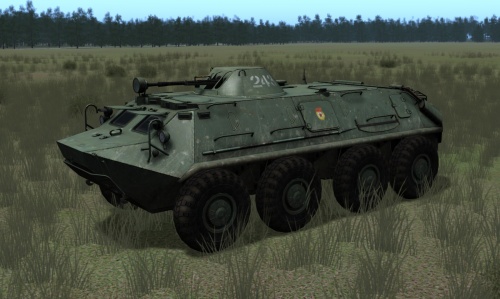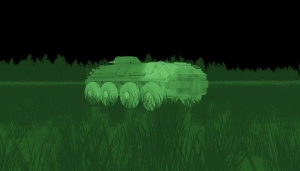BTR-60PB: Difference between revisions
mNo edit summary |
mNo edit summary |
||
| (4 intermediate revisions by the same user not shown) | |||
| Line 4: | Line 4: | ||
== Statistics == | == Statistics == | ||
HMG: 14.5mm | HMG: 14.5mm KPVT<br> | ||
Ammunition Stowage: 50 ready/450 stowed<br> | Ammunition Stowage: 50 ready/450 stowed<br> | ||
Default Ammunition: 50/450 14.5mm B-32 AP<br> | Default Ammunition: 50/450 14.5mm B-32 AP<br> | ||
Coaxial MG: 7.62mm | Coaxial MG: 7.62mm PKT<br> | ||
Ammunition Stowage: 250 ready/1750 stowed<br> | Ammunition Stowage: 250 ready/1750 stowed<br> | ||
Default Ammunition: 250/1750 7.62mm RU<br> | Default Ammunition: 250/1750 7.62mm RU<br> | ||
| Line 19: | Line 19: | ||
Armor Protection:<br> | |||
Frontal Turret | Frontal Turret Armor: N/A<br> | ||
Frontal Hull | Frontal Hull Armor: Thin, Steel. Protected vs small arms and artillery splinters<br> | ||
Combat Mass: 10. | Combat Mass: 10.3 tonnes<br> | ||
Length: 7.56m<br> | Length: 7.56m<br> | ||
Width: 2.82m<br> | Width: 2.82m<br> | ||
Height: 2.31m<br> | Height: 2.31m<br> | ||
Engine Power: 2×90hp GAZ-40P 6-cylinder gasoline<br> | |||
Top Speed: 80 kph<br> | Top Speed: 80 kph<br> | ||
== General == | == General == | ||
Designed in the late 1950s by the Soviet Union as a replacement for the [https://en.wikipedia.org/wiki/BTR-40 BTR-40] and [https://en.wikipedia.org/wiki/BTR-152 BTR-152] wheeled APCs, the BTR-60 is the first vehicle in a series of eight-wheeled armored personnel carriers. A revolutionary APC design at the time, the BTR-60's engines are at the rear, placing the crew and infantry compartment forward. Initial production began in 1960 by ''Gorkovsky Avtomobilny Zavod'' (GAZ) with the BTR-60P, and continued through succeeding models until 1976. | |||
Designed in the late 1950s by the Soviet Union as a replacement for the BTR-40 and BTR-152 wheeled APCs, the BTR-60 is the first vehicle in a series of eight-wheeled | |||
Motive power is supplied by two 90hp GAZ-40P V-6 gasoline truck engines each powering two torsion bar sprung axles offering mobility roughly on par with the [[T-55A|T-55]]. As with other Soviet designs, the BTR-60 series is amphibious with minimal preparation. The vehicle's | Motive power is supplied by two 90hp GAZ-40P V-6 gasoline truck engines each powering two torsion bar sprung axles offering mobility roughly on par with the [[T-55A|T-55]]. As with other Soviet designs, the BTR-60 series is amphibious with minimal preparation. The vehicle's armor is light, sufficient against small arms fire and artillery splinter, but equivalent to contemporary APCs. Basic armament consists of the powerful 14.5mm KPV-T heavy machine-gun and a coaxial 7.62mm PKT machine-gun mounted in a one man BPU-1 turret. Secondary armaments include three infantry firing ports on the upper half of each hull side. | ||
The modeled version is the BTR-60PB produced from 1966 until 1976, featuring an fully enclosed troop compartment, re-positioned firing ports, additional vision blocks for the commander and driver, and improved sights for the machine guns. | The modeled version is the BTR-60PB produced from 1966 until 1976, featuring an fully enclosed troop compartment, re-positioned firing ports, additional vision blocks for the commander and driver, and improved sights for the machine guns. | ||
The [[Infantry Units#Mechanized Infantry|dismount section]] for the BTR-60PB is 8 men, carrying | The [[Infantry Units#Mechanized Infantry|dismount section]] for the BTR-60PB is 8 men, carrying 5 RPG-7M anti-armor weapons, a PKM machine gun, and 7.62mm rifles. | ||
Produced in large numbers, the BTR-60PB served as the principal APC supporting motor-rifle regiments throughout the late 1960s and early to mid 1970s until it was supplanted by the [[BTR-70]]. With the exception of specialized C<sup>2</sup> and communication vehicles, the BTR-60 is no longer a front line APC in Russian service, but due to the large number produced (30,000+), the old vehicle is still assigned to training and border protection units, along with reserve units. Heavily exported to Russo/Soviet satellites and client states, the design continues to serve in the armed forces of nearly three-score nations, concentrated mainly in Africa and the Middle East. | Produced in large numbers, the BTR-60PB served as the principal APC supporting motor-rifle regiments throughout the late 1960s and early to mid 1970s until it was supplanted by the [[BTR-70]]. With the exception of specialized C<sup>2</sup> and communication vehicles, the BTR-60 is no longer a front line APC in Russian service, but due to the large number produced (30,000+), the old vehicle is still assigned to training and border protection units, along with reserve units. Heavily exported to Russo/Soviet satellites and client states, the design continues to serve in the armed forces of nearly three-score nations, concentrated mainly in Africa and the Middle East. | ||
| Line 50: | Line 49: | ||
==Crew Positions== | ==Crew Positions== | ||
Please visit the [[BTR- | Please visit the [[BTR-70]] page for detailed information on the BTR-60PB's crew positions since both vehicles are functionally identical. | ||
[http://www.eSimGames.com/purchase.htm Purchase SB Pro PE]<br> | [http://www.eSimGames.com/purchase.htm Purchase SB Pro PE]<br> | ||
Latest revision as of 23:23, 6 September 2022
BTR-60PB: Armored Personnel Carrier
Statistics
HMG: 14.5mm KPVT
Ammunition Stowage: 50 ready/450 stowed
Default Ammunition: 50/450 14.5mm B-32 AP
Coaxial MG: 7.62mm PKT
Ammunition Stowage: 250 ready/1750 stowed
Default Ammunition: 250/1750 7.62mm RU
Grenade Launcher: N/A
Ammunition Stowage: 0 ready/0 stowed
Default Ammunition: 0/0 Smoke
Armor Protection:
Frontal Turret Armor: N/A
Frontal Hull Armor: Thin, Steel. Protected vs small arms and artillery splinters
Combat Mass: 10.3 tonnes
Length: 7.56m
Width: 2.82m
Height: 2.31m
Engine Power: 2×90hp GAZ-40P 6-cylinder gasoline
Top Speed: 80 kph
General
Designed in the late 1950s by the Soviet Union as a replacement for the BTR-40 and BTR-152 wheeled APCs, the BTR-60 is the first vehicle in a series of eight-wheeled armored personnel carriers. A revolutionary APC design at the time, the BTR-60's engines are at the rear, placing the crew and infantry compartment forward. Initial production began in 1960 by Gorkovsky Avtomobilny Zavod (GAZ) with the BTR-60P, and continued through succeeding models until 1976.
Motive power is supplied by two 90hp GAZ-40P V-6 gasoline truck engines each powering two torsion bar sprung axles offering mobility roughly on par with the T-55. As with other Soviet designs, the BTR-60 series is amphibious with minimal preparation. The vehicle's armor is light, sufficient against small arms fire and artillery splinter, but equivalent to contemporary APCs. Basic armament consists of the powerful 14.5mm KPV-T heavy machine-gun and a coaxial 7.62mm PKT machine-gun mounted in a one man BPU-1 turret. Secondary armaments include three infantry firing ports on the upper half of each hull side.
The modeled version is the BTR-60PB produced from 1966 until 1976, featuring an fully enclosed troop compartment, re-positioned firing ports, additional vision blocks for the commander and driver, and improved sights for the machine guns.
The dismount section for the BTR-60PB is 8 men, carrying 5 RPG-7M anti-armor weapons, a PKM machine gun, and 7.62mm rifles.
Produced in large numbers, the BTR-60PB served as the principal APC supporting motor-rifle regiments throughout the late 1960s and early to mid 1970s until it was supplanted by the BTR-70. With the exception of specialized C2 and communication vehicles, the BTR-60 is no longer a front line APC in Russian service, but due to the large number produced (30,000+), the old vehicle is still assigned to training and border protection units, along with reserve units. Heavily exported to Russo/Soviet satellites and client states, the design continues to serve in the armed forces of nearly three-score nations, concentrated mainly in Africa and the Middle East.
Thermal Signature
Crew Positions
Please visit the BTR-70 page for detailed information on the BTR-60PB's crew positions since both vehicles are functionally identical.


